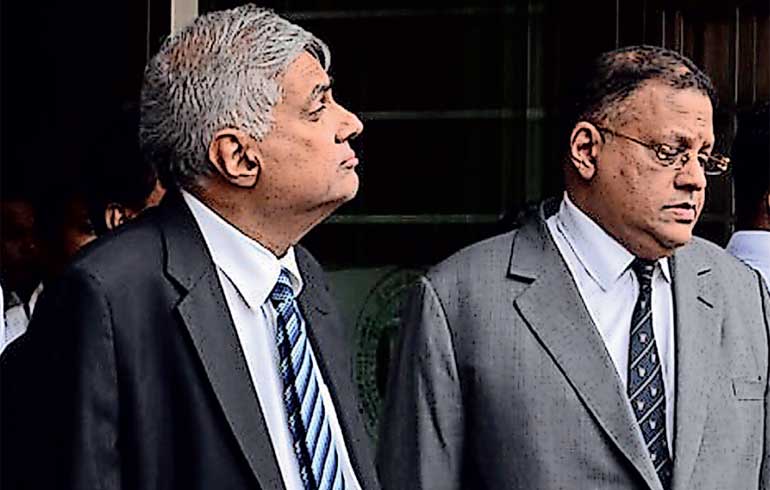-By LeN Special Investigation

(Lanka-e-News - 02.Oct.2025, 11.30 PM) On 27 February 2015 a routine government debt auction went badly, conspicuously wrong — and a national controversy was born.
The Central Bank of Sri Lanka (CBSL), under newly appointed Governor Lakshman Arjuna Mahendran, advertised a 30-year Treasury bond worth Rs. 1 billion at a coupon that surprised markets: 12.5%. The offer was wildly oversubscribed; bids totalling roughly Rs. 20 billion were lodged, and the bank accepted roughly Rs. 10 billion at rates ranging from about 9.5% up to 12.5% — far above the market’s expectation that yields should fall. Within days, questions multiplied about who benefited, how the decision had been taken, and whether the auction mechanism itself had been abused.
What followed was not merely a dispute over millions of rupees. It became a locus for wider anxieties: about regulatory capture, insider information, political influence, and the robustness of institutions charged with protecting public funds. A succession of inquiries, media exposes and legal actions over the next decade would keep that single auction at the centre of Sri Lanka’s political and financial life
At the heart of the controversy was a switch in the method of sale. For years the Public Debt Department (PDD) of the Central Bank had used a hybrid mechanism — an auction combined with a “direct placement” (or direct replacement) facility that gave the regulator a degree of control over allotments and price formation. On 27 February 2015 the bank moved to an auction-only model. Critics say that change, abrupt and unexplained, removed a key market stabiliser and handed advantage to well-connected primary dealers able to trade on privileged intelligence. Proponents argued the move was simply a modernisation step. The difference in practice, however, proved politically explosive.
The bond commission set up later to probe the episode highlighted how the altered procedure permitted a small number of primary dealers to secure outsized allocations — including Perpetual Treasuries Ltd (PTL), the primary dealer that acquired Rs. 5 billion of the bonds at the top coupon. PTL’s ownership and affiliations immediately made the transaction politically toxic: the company was linked to Arjun Aloysius, the son-in-law of Governor Mahendran. The apparent proximity between the governor and a beneficiary firm transformed a technical auction question into an allegation of conflict and possible illegality
Official estimates of the economic loss have been contested and litigated. Early figures circulated in public discourse put the cost to the public purse at roughly Rs. 1.6 billion (about US$10–11 million) for that single auction; other assessments and later court filings argued smaller or differently calculated amounts. Regardless of the precise arithmetic, the political fallout — resignations, commissions of inquiry and enduring public suspicion — far outstripped the headline number
A Presidential Commission of Inquiry and subsequent parliamentary probes assembled a large dossier: minutes, emails, testimony and market data. The Commission concluded there were serious irregularities, and its report stated that inside information appeared to have been provided to PTL, and that the governor’s family connections created an unacceptable conflict of interest. Those findings were damning in tone but not prosecutions in themselves; they instead fed into parallel criminal and corruption investigations.
At the same time, defenders of the 2015 decisions — including some senior politicians and economists — pointed to pre-existing market practices and prior bond allocations to argue that the auction was within a continuum of Central Bank operations. They urged caution about pinning blame on one day’s mechanics or on individual actors until criminal processes had run their course. The dispute between legal process and political narrative has been one of the scandal’s defining features
Insiders and market veterans explained the practical problem simply: in an opaque market, those with timely, granular information can act faster and take positions that shore up quick profits when secondary market yields move in predictable ways. The auction-only method amplified that effect, according to critics, because it removed the PDD’s discretionary tool that previously helped manage supply and temper yield spikes. With the PDD’s capacity curtailed, primary dealers that had access to non-public signals could secure allocations that allowed profitable downstream trades.
The scandal has been inseparable from politics. Allegations and counter-allegations tied to the then-Prime Minister, the Central Bank governor and senior financial actors have dominated headlines and parliamentary debates for years. Some inquiry transcripts and media reports include claims and counterclaims about whether political instructions or pressures shaped the decision to alter the auction mechanism. Others point to institutional failures: why the Monetary Board, the Attorney-General’s Department and law-enforcement bodies did not act sooner or more decisively.
Legal action continued to move slowly. Sri Lanka sought cooperation from foreign jurisdictions, and the question of extradition for suspected actors based overseas — most prominently the former governor, who has spent time in Singapore — became a diplomatic and legal knot that illustrates how financial crime probes collide with international law and politics. Singapore’s responses to extradition requests have been cautious and conditioned on legal thresholds being met.
-By LeN Special Investigation
---------------------------
by (2025-10-02 19:34:04)
Leave a Reply